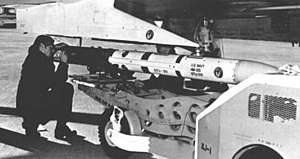Brazo
The Brazo (/ˈbrɑːsoʊ/) missile was an American project, intended to produce an anti-radiation missile for air-to-air use. Developed by Hughes Aircraft and based on the AIM-7 Sparrow air-to-air missile, the Brazo underwent a series of successful test firings; however, the program was terminated at the end of its test program.
| Brazo | |
|---|---|
 Brazo/PAVE ARM missile | |
| Type | Anti-radiation missile |
| Place of origin | United States |
| Service history | |
| Used by | United States Air Force; United States Navy |
| Production history | |
| Designed | 1972-1973 |
| Manufacturer | Hughes Aircraft |
| Specifications | |
| Length | 12.0 feet (3.66 m) |
| Diameter | 8 inches (200 mm) |
| Warhead | Continuous rod |
| Warhead weight | 65 pounds (29 kg) |
| Engine | Rocketdyne Mk 38 |
| Wingspan | 3.3 feet (1.02 m) |
| Propellant | Solid fuel |
Operational range | 16 nautical miles (30 km; 18 mi) |
| Maximum speed | Mach 4 |
Design and development
A joint development project between Hughes Aircraft and the United States Navy,[1] the Brazo missile (named as a pun by one of the project's Navy developers, a Hispanic; "Brazo" is Spanish for "Arm", the acronym for an Anti-Radiation Missile[2]) project was initiated in 1972, as a proof-of-concept demonstration of the utility of an air-to-air, anti-radar missile.[1] In 1973, the United States Air Force's Pave Arm project, a program with similar goals, was merged into the Brazo program, with the Air Force assuming responsibility for testing the missile.[3]
The first air-to-air anti-radiation missile developed by the United States,[4] the Brazo utilised the airframe of the existing AIM-7E Sparrow air-to-air missile, fitted with a new, Hughes-built passive radar seeker head developed by the Naval Electronics Center.[5] The seeker was intended to detect and home on enemy radar emissions, such as those on interceptor and AWACS aircraft.[6]
Operational history
The first test firing of the Brazo missile was conducted in April 1974, with the missile, launched from a USAF F-4D Phantom II,[7] successfully shooting down a BQM-34 Firebee drone; four follow-up tests over the following year continued the missile's successful record, with none of the test shots failing[1] despite difficult test conditions.[3] However, despite the Brazo's success, the follow-on ERASE (Electro-magnetic RAdiation Source Elimination) project was cancelled,[8] and no air-to-air antiradiation missiles would enter service in the West.[9]
See also
- AIM-7 Sparrow
- AIM-97 Seek Bat
- R-27 (air-to-air missile)
References
Notes
- Parsch 2003
- Stevenson 2001, p.18.
- Friedman 1982, p.179.
- Morison and Rowe 1975, p.282.
- Fitzsimons 1978, p.425.
- Gunston 1977, p.96.
- International Aeronautic Federation (1974). Interavia volume 29, p.603.
- Bidwell 1978, p.165.
- Sweetman 1987, p.160.
Bibliography
- Bidewell, Shelford (1978). World War 3: A Military Projection Founded on Today's Facts. London: Hamlyn Publishing Group. ISBN 978-0-600-39416-7.
- Fitzsimons, Bernard (1978). The Illustrated Encyclopedia of 20th Century Weapons and Warfare. Columbia House. ASIN B000RUOW6Q.
- Friedman, Norman (1982). U.S. Naval Weapons: Every gun, missile mine and torpedo used by the US Navy from 1883 to the present day. Annapolis, MD: Naval Institute Press. ISBN 978-0-87021-735-7.
- Gunston, Bill (1977). F-4 Phantom. New York: Scribner. ISBN 978-0-684-15298-1.
- Morison, Samuel L.; John S. Rowe (1975). The Ships & Aircraft of the U.S. Fleet (10th ed.). Annapolis, MD: United States Naval Institute. ISBN 0-87021-639-2.
- Parsch, Andreas (2003). "Hughes Brazo". Directory of U.S. Military Rockets and Missiles. designation-systems.net. Retrieved 2010-12-29.
- Stevenson, James Perry (2001). The $5 Billion Misunderstanding: The Collapse of the Navy's A-12 Stealth Bomber Program. Annapolis, MD: Naval Institute Press. ISBN 978-1-55750-777-8.
- Sweetman, Bill (1987). Advanced Fighter Technology: The Future of Cockpit Combat. Osceola, WI: Motorbooks International. ISBN 978-0-87938-265-0.